Installing Exchange 2003 into the Exchange 5.5 Site
We now have to install an Exchange Server 2003 in our Windows Server 2003 forest, so we’ll need to run forestprep and domainprep. If you used the ADSIEdit tool, you’d find at this juncture that the Exchange organization object is not yet defined in the configuration partition of Active Directory other than to have a globally unique identifier (GUID), as Figure 15-23 illustrates. After installing the first Exchange Server 2003 into the Exchange 5.5 organization, this organization object is renamed to the Exchange 5.5 organization name—in our scenario, Trains.
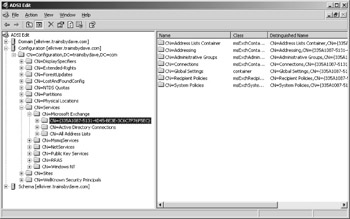
Figure 15-23: Exchange organization object, defined so far in Active Directory with only a GUID.
Let’s start the Exchange Server 2003 installation in the Windows Server 2003 forest. Because we have the ADC installed, this installation will vary from a new installation of Exchange 2003 in that after the Component Selection page, you are presented with an Installation Type page in which you can choose to join an existing Exchange 5.5 organization or create a new organization. The choice you make here will have an impact on the rest of your migration. There is no rollback option, and you cannot change your mind later, so be sure you know exactly what you want to do.
If you choose to create a new organization, you are forced to use another utility to migrate the mailboxes. If you install Exchange Server 2003 into an Exchange 5.5 site, you can use the Move Mailbox tool and re-home your public folders to migrate information to Exchange 2003, as shown in Figure 15-24. Using Move Mailbox avoids a lot of headaches and saves you time, and it is our preferred approach.
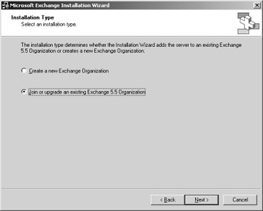
Figure 15-24: Choosing to install Exchange Server 2003 into an Exchange 5.5 organization.
In the next page, you are asked to enter the name of an Exchange 5.5 server so that you can join the Exchange 5.5 site. We’ll enter the PDC1 server name to install our Exchange Server 2003 into the Corp 5.5 site. Click Next.
Remember that to install the Exchange Server 2003 into any Exchange 5.5 site, the account under which you are installing Exchange 2003 must have administrator permissions on the site and configuration objects in the target Exchange 5.5 site; thus, a trust relationship must be established between your forest and the host Windows NT domain for the Exchange 5.5 site. You also will want to add the Active Directory Domain Admins security group to the local Administrators group on the Windows NT server. Finally, to finish the Exchange 2003 installation, you’ll need the Exchange 5.5 service account password. You can run through the rest of the Exchange 2003 installation without explanation since each page is self-explanatory.
| Tip | Before finishing the Exchange 2003 installation, if you want to, you can install the Exchange 5.5 Administrator tool on your Exchange Server 2003 so that you can manage both environments from the same location. To do this, select a Custom installation in the Components Selection page, and then select to install the Exchange 5.5 Administrator tool. |
After Exchange 2003 is finished installing, you will notice two things immediately. First, in the Exchange System Manager (ESM), the First Administrative Group is named after the site into which you installed Exchange Server 2003, which, in this case, is Corp. Second, the Exchange 5.5 Server appears as a transparent object. The transparency is a visual reminder that the server is running Exchange 5.5, not Exchange 2003 (Figure 15-25).
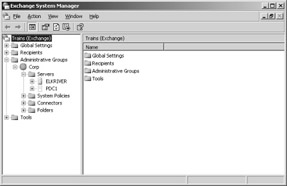
Figure 15-25: ESM for Exchange 2003.
Also notice in ADSI Edit that the organization object has been renamed to the same name as the Exchange 5.5 organization, in this case, Trains (Figure 15-26).
| Planning | If you want a different organization name, you must rename the Exchange 5.5 organization before you install the first Exchange 2003 server into the organization. You can do this using the Raw Properties option of the Exchange 5.5 Administrator. To run the Administrator in this mode, navigate to the \exchsrvr\bin directory from a command prompt, and type admin /r. From there, you should be able to open the properties of the organization object and change the display name of the organization. Exchange 2003 picks up this display name and uses it for the organization name in Active Directory. |
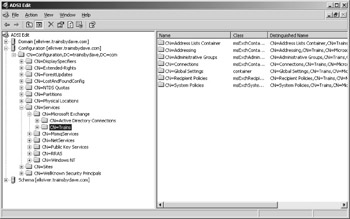
Figure 15-26: The organization object renamed to the same name as the Exchange 5.5 organization—in this case, Trains.
In the Exchange 5.5 Administrator, the Exchange Server 2003 appears in the Corp site as another server. Also, when the Exchange Server 2003 is highlighted, in the right pane appears (with other objects) the Site Replication Service (SRS). (We discuss the SRS in Chapter 16, but briefly, the SRS acts like the directory service on an Exchange 5.5 server but replicates site and configuration information back to the Active Directory configuration partition.) Because of the SRS’s involvement in the ESM, other sites in the Exchange 5.5 organization appear as Administrative Groups (Figure 15-27), and the objects appear as transparent to indicate they are Exchange 5.5 objects.
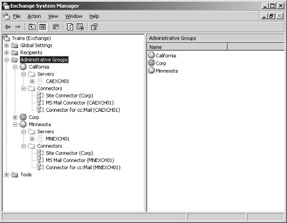
Figure 15-27: ESM illustration of other Exchange 5.5 sites appearing as transparent objects.
Your next step in the migration is to use the Move Mailbox feature in ADUC to transfer the mailboxes from the Exchange 5.5 server in the Corp site to the ElkRiver Exchange 2003 server. In the Exchange Tasks Wizard shown in Figure 15-28, the Exchange 5.5 servers (PDC1, MNEXCH01, and CAEXCH01) are listed with the Exchange Server 2003 (ElkRiver). This gives you the ability to use the same interface to move mailboxes between Exchange 2003 and Exchange 5.5 servers—very nice!
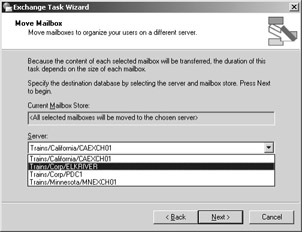
Figure 15-28: Move Mailbox page in the Exchange Task Wizard in ADUC.
| Tip | Depending on the number and size of mailboxes to be moved, the actual move can take minutes or hours. Since the user cannot access his mailbox while it is being used, best practice here is to perform this activity during off-business hours. |
EAN: 2147483647
Pages: 254